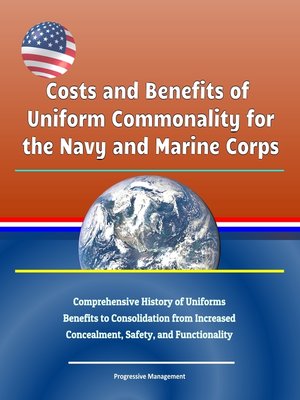Costs and Benefits of Uniform Commonality for the Navy and Marine Corps
ebook ∣ Comprehensive History of Uniforms, Benefits to Consolidation from Increased Concealment, Safety, and Functionality

Sign up to save your library
With an OverDrive account, you can save your favorite libraries for at-a-glance information about availability. Find out more about OverDrive accounts.
Find this title in Libby, the library reading app by OverDrive.



Search for a digital library with this title
Title found at these libraries:
| Library Name | Distance |
|---|---|
| Loading... |
This mid-2018 report has been professionally converted for accurate flowing-text e-book format reproduction. This research used uniforms of the United States Navy and Marine Corps to explain the costs and benefits of the services consolidating uniforms and wearing a single functional uniform. This study examined the history of Navy and Marine Corps uniforms. It analyzed benefits and costs, as well as identified impediments to implementing a single functional uniform for use at Contiguous United States (CONUS) and Outside Continental United States (OCONUS) duty stations. The research team concluded that there are many possible benefits to consolidation such as increased concealment, safety, and functionality. After analyzing eight possible courses of action (COA), the research team concluded that COA 4, both the Navy and Marine Corps utilizing the Marine Corps Combat Utility Uniform (MCCUU) Flame Resistant (FR) variant, resulted in the greatest number of benefits and the highest weight of perceived benefits to the warfighter.
The distinction between United States Armed Forces uniforms allows service members to immediately possess a strong sense of pride for their selected service. Separate, distinct uniforms also contribute to the uniqueness of each military branch of service and the respective roles each service plays in the defense of the United States of America. Additionally, officers and enlisted have different uniforms to ensure distinction between the different groups of service members. The Navy has a common uniform worn by all called the Navy Working Uniform (NWU) in three variants. The Marine Corps also has a common uniform that comes in two variants called the Marine Corps Combat Utility Uniform (MCCUU). The Marine Corps administratively falls under the Department of the Navy, yet the Navy and Marine Corps each have their own sets of uniforms. The current method for uniform procurement is performed independently by each branch and over the last eighteen years, both services have fielded different combat uniforms to go along with the different utility and dress uniforms. The Fiscal Year 2014 National Defense Authorization Act, Section 352, calls for the elimination of the "development and fielding of Armed Force-specific combat and camouflage utility uniforms and families of uniforms in order to adopt and field a common combat and camouflage utility uniform or family of uniforms for specific combat environments to be used by all members of the Armed Forces" (National Defense Authorization Act [NDAA], 2014).







